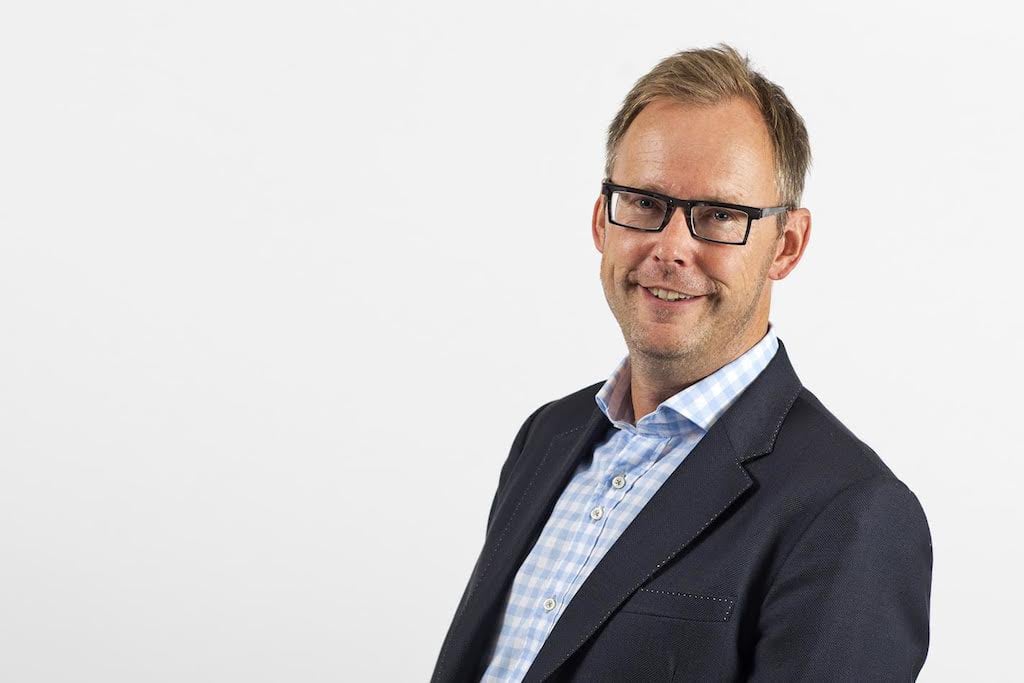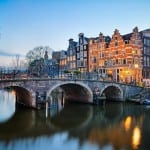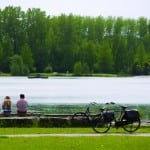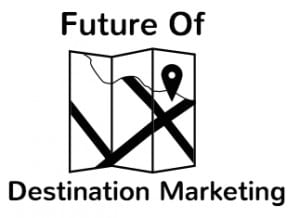Skift Take
Holland City is one of the most clever concepts we've seen from a DMO. Tourists won't visit the other Dutch cities just because Visit Holland says they're close by but it will do a lot to build a stronger, more unified brand.
- Visit Holland CEO Jos Vranken
- A canal in Amsterdam
- Tourists biking in Holland
Editor’s Note: Skift is publishing a series of interviews with CEOs of destination marketing organizations where we discuss the future of their organizations and the evolving strategies for attracting visitors. You can read all the other interviews here.
This continues our series of CEO interviews that began with online travel CEOs in Future of Travel Booking (now an e-book), and continued with hotel CEOs in the Future of the Guest Experience series (which is also an e-book).
Between Holland’s iconic tulips, its well-known canals, and bicycle culture, this small European country certainly isn’t unknown to international travelers.
But Visit Holland must continuously reinvent incentives in order to move tourists beyond Amsterdam’s charm and out into the countryside and other cities. In 2014, the country welcomed 14 million international visitors who spent 10.2 billion euro ($11.5 billion), about 40% of which was spent in Amsterdam alone, the Netherlands’ largest city and arguably biggest attraction.
Skift recently talked to Visit Holland’s CEO Jos Vranken about the organization’s new effort to market Holland as one gigantic city made up of distinctive neighborhoods rather than a country, how he and his team deal with funding cuts, and his thoughts on a “tourist cap” for Amsterdam. An edited version of the interview follows:
Skift: Of the 14 million international travelers who visited Holland last year, less than half (5 million) went to Amsterdam. This seems a little surprising since I would think Amsterdam is your main draw and more would visit that city. Why is this the case?
Jos Vranken: The reason why so many don’t go to Amsterdam is because for our two largest markets, Belgium and Germany, Amsterdam is not the primary reason they visit. Germans love our beaches, Belgians love our coast as well and do our bicycling through back roads. Germans are our largest source market of all international visitors (26%), followed by the U.K., then Belgium and then the U.S. China is growing too (20%) and we’ve seen double digit growth with that market during the past few years. The North American market grew about 6 to 7% year-over-year after a small dip and we anticipate hitting 1 million visitors this year from North America.
Because of the share volume of Germans they top everyone else for total spending but they still spend less per person, so the U.S. and Canadians are worth more for spend per person. The 4 million Germans who visit us stay a little longer but spend a lot less because they’re often staying in bungalows but Americans are largely staying in hotels.
The biggest growth will come from emerging markets because of the rise of middle class consumers and Europe is well-positioned to welcome all of them. We definitely know it’s necessary to keep growing our neighboring markets and North American markets and for a lot of our Dutch partners it’s very important we keep growing visitor arrivals from North America.
Skift: Your recent Van Gogh Twitter campaign sought to get your target markets even more interested in Holland as a destination. The campaign started a few months ago; where is it at now?
Vranken: The Van Gogh campaign with Expedia is finishing as we speak and it’s part of a larger context of spreading people throughout Holland. For the next few years we’re focusing on a concept called Holland City which basically is mentally making Holland smaller than it already is. We’re positioning Holland as a city destination rather than a country because we see that most of our international visitors to Holland come from large metropolitan areas throughout the world.
If you look at areas like New York and L.A. and look at their perception of distance and particularly travel time we see that Holland is really a city destination for them. That opens up a lot of new opportunities to market different parts of Holland by this changing of the mental positioning of our country and this is the context for our Van Gogh campaign. In order to conceptualize Holland City we needed to create an alliance with partners in Holland like the Van Gogh Museum and the City of Amsterdam for example.
Traveling from Amsterdam or Schiphol Airport to somewhere in the south of Holland is no more than the daily commute for people in places like Beijing or Tokyo or New York and sometimes it actually takes less time. We’re really trying to project Holland City as the experience that people have in their own country and that’s again where our Van Gogh campaign came into play.
For that campaign we focused on three target markets, the U.K., France and Germany which are three of the top five source markets for Holland. We wanted to engage people through social media and Expedia for us is a tremendously important travel platform for conversion reasons so we got together with them and out of that came this campaign which gave people chances to win trips to the Netherlands. The results have been pretty good and what we wanted was to drive reach and of course to increase actual travel to Holland.
What we’ve seen over a six-week period of the campaign is that we’ve reached about 2.2 million Twitter impressions and engagements that exceeded 22,000 so that’s pretty good and more importantly we saw the demand for the Netherlands on the Expedia platform during the campaign show double-digit growth as we recorded a 34% lift in travelers to Holland throughout the campaign period. It really was an initiative that we’d like to explore further for other subjects and events because the initial results were promising.
Skift: So why choose Expedia to partner with on this campaign versus another third party creative agency?
Vranken: There are a number of reasons for that and as a DMO we create platforms for both domestic and international partners to help drive traffic to Holland and in this case Expedia is one of them. And then it comes down to is the willingness of partners to co-invest in initiatives like this as well as the ability to target one of our target groups effectively. This time we chose Expedia but it could be someone else in the future but certainly our partnership with Expedia is growing. And as you probably know we’ve also been working with Orbitz in the U.S. and we work with Booking.com as well. So in this sense it’s a wide partner network and we pick and they pick us for projects at any given time.
Skift: Even though Holland is small it still won’t be easy convincing tourists that distance isn’t an issue getting around the country. How are you working against this?
Vranken: I don’t think the concept of Holland City has yet been established but we’ve already started getting this mental positioning out there. As you can imagine you need to start in the Netherlands itself to get support for Holland City and one of the tools we put out there is a tube or subway map projected on Holland. Obviously we don’t have a subway covering Holland as such but it sort of mentally drills down the message that we really are a city rather than a country in national terms.
What I like the most about the tube map is that we portray tube lines and some people might say we’re crazy for living in such a low country that’s a few meters below sea level. This is one of our most intriguing stories but it’s not always obvious when you go to Holland so one of the tube lines is the water line that you can take. This route will bring you to different places where you can experience this story of living below sea level and what we do is get the people together who represent these ‘tube stops’ and try to establish a partnership that delivers a marketable travel proposition.
If you get bored with the water story you can ‘change lines’ to the flower line where you can experience the tulip story, etc. This whole concept is still early but we’ve literally gone out there to cities like Rotterdam and The Hague, our second and third largest cities, and told them that they’re basically a district or borough in Holland City. At first they have to let that sink in a little but they understand the concept because every great city in the world needs to have these diverse districts.
Skift: What are some other ways you’re showing people what Holland is really like and that it’s worth a visit?
Vranken: We’re in the midst of a video series that we’re really excited about. As the series is still running I don’t have actual facts and figures to share but I do have initial anecdotal feedback. We’re experimenting with 15 very short videos that you can say are much shorter than normal. They’re deliberately short because we wanted to make them shareable, snackable content that we also could use cross media. And we want to have it throughout the four seasons as well and they’ll vary from the beach to falling in love to museums to kids’ videos.
I think one of the underlying reasons that we did these videos also has to do with funding in many cases because again, if you don’t have the huge funding that other countries may still have to run big digital awareness campaigns you have to go via another route.
So what we tried to do with the “Holland: The Original Cool” or “This is Holland” campaigns is help us stick out and we create noise about the brand in a way that is different and maybe a little bit off the beaten path for DMOs. And in many cases it’s our way of dealing with smaller budgets than some others. In Holland we say “if you’re not the biggest you have to be the smartest.” I’m not saying we are but we are trying.
Skift: It sounds like funding is a problem for you. What’s the relationship like between Visit Holland and the Dutch government and what is your funding model? Do you feel your organization receives enough government funding?
Vranken: Governments cant seem to get out of the fun zone with tourism even though it’s a major economic factor. In Holland there is a strong lobby going on right now to get the sector as a whole out of the fun zone and into the economic zone which will provide better opportunities for us. In Holland we have a public/private model since we were established and I wouldn’t have it any other way.
The risk with the Dutch government is if you’re successful with attracting private sector funding the government thinks they don’t need to contribute as much. Our answer to that is no, you should do more. Private sector money is a different kind of money with different goals and with different scope and different terms.
Where the private sector looks for quick ROI and for benefits that help them drive and realign their own goals, the government money really provides the mid and long-term focus positioning of our destination and the context in which private partners can act. And the government money allows us to facilitate the partnerships we need. At the moment we’re right in the middle of that lobby to secure more funds for the next four years.
Skift: How do you think this will play out for you?
Vranken: What we’re also seeing in Holland is that our government continues investing in tourism but at decreasing levels which we don’t necessarily appreciate or like but it’s a reality we face at the moment. Meaning that for us it’s very important to connect with the international and domestic travel trade and with stakeholders who have an equal interest in driving traffic and spend with international visitors to our country.
In the last couple years we’ve really tried to play a bigger role in the entire funnel, where we help the traveler go from inspiration to conversion. We are not a market player ourselves and we have no ambition to become a market player, that’s where market players come in. But we work with those partners to provide the final part of the puzzle.
Visit Holland received 16.6 million euro ($18.7 million) per annum in 2011 from the government and now we’re at 8.4 million ($9.5 million) per annum from the government and that’s our base funding for the next few years. We get about 11 million euro ($12.4 million) per annum from the private sector so all in all that gives us a 20 million euro ($22.5 million) annual budget.
If we look at other European countries we’re being compared by our national government to the likes of the U.K., Scandinavia and Belgium. We’re in the penultimate position with regard to funding and thus being ‘compared’ to emerging EU destinations whereas we are actually benchmarked against the likes of mature destinations like the U.K., Germany, etc. You can’t have everything for nothing we tell people.
Skift: I’d imagine if you suddenly had 10 times more funding than you have right now there would be a lot more possibilities?
Vranken: We would still focus on our target markets I mentioned earlier but would focus more on branding and positioning of Holland and accelerate the Holland City concept and build a stronger public/private partnership. We wouldn’t discard the public/private model but would look at it with a long-term government funding perspective and a short-term commercial or private perspective. This would in turn give us a stronger negotiation position for funding.
Skift: I want to ask you about something Barcelona’s mayor recently said about imposing a tourist cap on that city to help protect it from becoming another Venice. Where do you stand on something like this?
Vranken: I would never propose something like the Barcelona mayor proposed. If you put a cap on tourism, you might as well put a fence around the city and start leveraging an entrance fee. But large capitals around the world are facing huge numbers of visitors so what I do appreciate is cities coming up with smarter strategies to keep their destinations livable in the future, what we call ‘supporting the old, introducing the new.’
We’re currently negotiating with City of Amsterdam on events that will help disburse visitors throughout different seasons like the Amsterdam Light Festival. And we’re also trying to show that Holland is profitable for local entrepreneurs, lovable for future guests and livable for locals.
Skift: Related to tourists caps, locals in some cities around the world complain that growing platforms such as Airbnb have filled their neighborhoods with transient tourists who aren’t always the most respectful and have changed the entire dynamic of some neighborhoods. Does your organization have an opinion on the sharing economy and whether or not it’s helping or hurting Holland in particular?
Vranken: We actually started a partnership with Airbnb earlier this year but we’re not a membership organization for different sectors within the industry. If the sharing economy is increasingly important we want to work with it to help with the branding of Holland to show we adapt to what our guests want. Incumbents share a bigger slice of the pie at the end of day rather than fueling more competition.
We did some digital campaigning with Airbnb as part of an element of Holland City and put emphasis on using Airbnb outside of current hotspots like Amsterdam. We’re focusing on cities that you could consider off the beaten track and we’re in the process of wrapping up and seeing how it played out with Airbnb. Rather than having an opinion about these sharing economy entrants from the side we’d rather work with them and see how it goes with them. This was jointly on Visit Holland and Airbnb’s websites and also on third-party platforms.
The Daily Newsletter
Our daily coverage of the global travel industry. Written by editors and analysts from across Skift’s brands.
Have a confidential tip for Skift? Get in touch
Tags: ceo interviews, fodm, tourism, visit holland
Photo credit: Visit Holland's CEO Jos Vranken. Visit Holland





